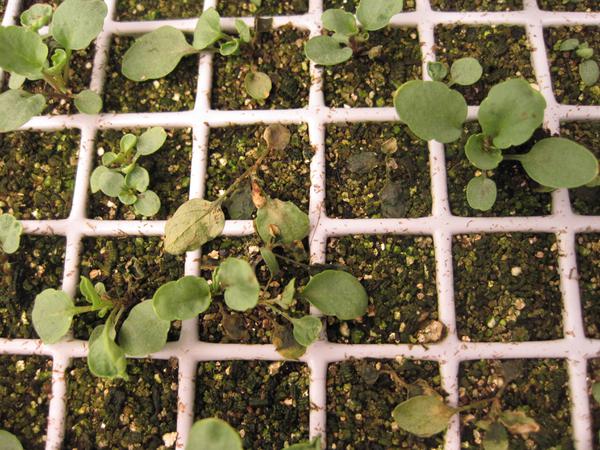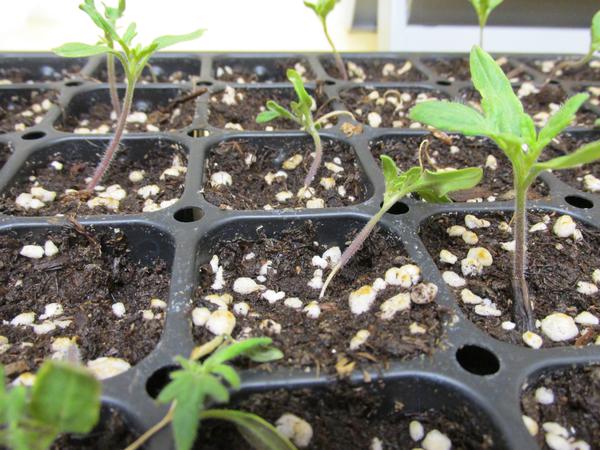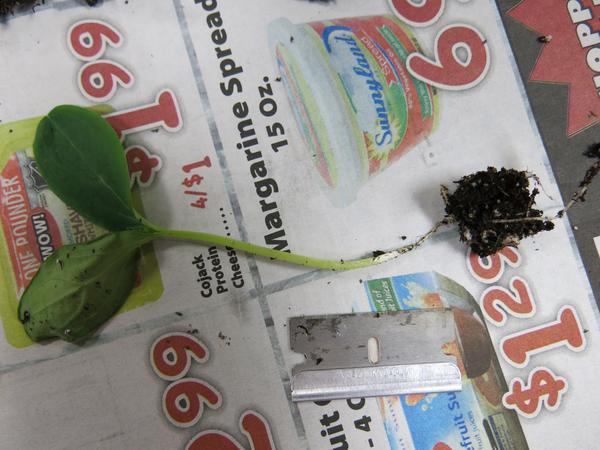Pathogens
Damping-off is primarily caused by fungi present in the growing medium. The fungi include species of Rhizoctonia, Pythium, Fusarium, Phytophthora, Sclerotinia, Sclerotium, Botrytis, and others. Germinating seed and seedlings, especially weak ones, are vulnerable to attack by these fungi during periods of unfavorable growing conditions. Species of Pythium, Sclerotinia, and Phytophthora are more likely to cause damping-off in cool, wet soils; whereas species of Rhizoctonia, Fusarium and Sclerotium rolfsii may cause damping-off under warmer and drier conditions.
Symptoms and Signs
Typical symptoms of damping-off are rotting stems at or near the soil line and root decay (post-emerging damping off). Affected areas in the seed bed are usually a foot or more in diameter with shriveled brown, collapsed or stunted seedlings. Rhizoctonia, Fusarium, Sclerotinia, and Sclerotium generally caused post emergence damping-off by killing the seedling at the soil line. Pythium attacks below the soil line, often at root tips.
Moldy fungal growth may be seen on affected plants at the soil line. Germinating seed can also be attacked by these fungi before they emerge from the soil (pre-emerging damping off), resulting in poor stands.
Similar Diseases
True damping-off may be confused with plant injury caused by excessive fertilization, high soluble salts, drowning in wet soil, desiccation in dry soil, and death of seedlings from excessive heat, cold, fuel fumes, or chemical injury. This type injury often damages the leaves and upper stem before the roots are affected. Typically, plants affected by damping-off will be scattered or occur in patches whereas plants affected by abiotic issues mentioned above will be more consistently affected and at or near 100% incidence.
Prevention & Cultural Management
The best control of damping-off is to avoid it altogether. Once damping-off has started in a plant bed or seedling flat, it may be difficult to control. The general methods employed to prevent damping-off consists of:
- Sanitize all seed trays and flats and store them in a clean location when not in use.
- Proper soil preparation and management to provide for good soil drainage, structure, aeration, water-holding capacity and plant nutrition by including proper amounts of fertilizer and lime according to the soil test report.
- Proper soil treatment with heat or chemicals to reduce the level of fungi that cause damping-off.
- The use of fungicide-treated seed with high germination (see North Carolina Agricultural Chemicals Manual; specify treated seed before purchasing),
- Proper seeding rates to avoid thick plant stands, poor air movement and low light intensity.
- Proper planting depth and soil temperature to assure rapid seeding emergence and growth.
- Strict sanitation to avoid reinfesting treated soil with these fungi. Many outbreaks of damping-off in North Carolina can be attributed to poor sanitation practices after treating the soil. For bedding plant operations, it may be more practical to buy a sterilized soilless mix and eliminate steps 1 and 2 above.
Once damping-off has started in a bed or flat, its spread may be reduced by providing drier conditions for better seedling growth. This can be done by increasing greenhouse temperature, increasing air circulation and ventilation, reducing the frequency of watering, providing better water drainage by ditching inside and outside the plant bed structure or greenhouse, and by increasing the amount of light by removing dirty covers, overhanging branches, removing shading materials, etc.
Chemical Control
If the above preventive control measures fail, several fungicides are available that may be effective if applied as a drench or heavy spray as soon as the first symptoms of damping-off are observed. Growing conditions should be improved and flats or areas of bed with damping-off should be carefully removed from the growing area. Rapid identification of the causal fungus should be obtained so that proper chemicals can be applied (see county agent for diagnosis). Several applications of the fungicide may be necessary, If the specific fungus causing damping-off is not known, one broad spectrum fungicide (captan or ferbam), two specific fungicides (benomyl plus, etridiazole or metalaxyl) or a prepared combination of fungicides (etridiazole + thiophanate methyl) should be used. Check the current North Carolina Agricultural Chemicals Manual and the label carefully to be sure of the proper fungicide and rate to be used on a particular crop.
Some fungicides used to control damping-off are listed below along with general rates (follow specific crop limitations and rates on the manufacturer's label):
| Trade Name* | Active Ingredient | FRAC | Use |
| Banrot 40 WP (B.S.) | etridiazole + thiophanate-methyl | 14+1 | Ornamentals |
| Banrot 8 G (B.S.) | etridiazole + thiophanate-methyl | 14+1 | Ornamentals |
| Benlate 50 WP (R) | benomyl | 1 | Ornamentals |
| Captan 50 WP (B.S.) | captan | M04 | Ornamentals |
| Chipco 26019 WP (R) | iprodione | 2 | Ornamentals |
| Cleary's 3336 WP (R) | thiophanate methyl | 1 | Ornamentals |
| Domain FL (R) | thiophanate methyl | 1 | Ornamentals |
| Ferbam 76 WP (B.S.) | ferbam | M03 | Ornamentals |
| Heritage (R) | azoxystrobin | 11 | Ornamentals |
| Truban 30 WP (P) | etridiazole | 14 | Ornamentals |
| Truban 25 EC (P) | etridiazole | 14 | Ornamentals |
| Truban 5G (P) | etridiazole | F14 | Ornamentals |
| Subdue 2E (P) | metalaxyl | 4 | Ornamentals |
| Subdue 2G (P) | metalaxyl | 4 | Ornamentals |
| LInebacker (P) | aluminum tris phosphonate | 33 | Vegetables |
| Previcur Flex (P) | propamocarb hydrochloride | 28 | Vegetables |
| Ranman (P) | cyazofamid | 21 | Vegetables |
| *B.S. = (broad spectrum fungicide); R = (active against Rhizoctonia, Sclerotina, Fusarium, Botrytis); P = (active against Phytophthora and Pythium) | |||
All of these fungicides can cause some stunting and yellowing of young seedlings. Do not use fungicides unless damping-off becomes or has been a problem. Wait as long as possible before using a fungicide as younger seedlings are more susceptible to fungicide injury than older seedlings.
Organic Control
The following products are OMRI approved for damping off on vegetables or ornamentals. The best efficacy will be obtained if cultural practices explained above are employed in addition to any product application. As always, follow the label for specific instructions and crops labeled. Not all formulations are listed.
| Trade Name | Active Ingredient | FRAC | Use |
| Actinovate SP, STP | Streptomyces lydicus WYC 108 | BM 02 | Vegetables |
| Cease | QST 713 strain of Bacillus subtilis | 44 | Ornamentals, Vegetables |
| RootShield PLUS WP, RootShield PLUS Granules | Trichoderma harzianum Rifai strain T-22, Trichoderma virens strain G-41 | BM 02 | Ornamentals, Vegetables |
| SoilGard | Gliocladium virens strain GL-21 | BM 02 | Ornamentals, Vegetables |
| Subtilex NG | Bacillus subtilis strain MBI 600 | 44 | Ornamentals, Vegetables |
Additional Resources
- 2017 Southeastern US Pest Control Guide for Nursery Crops and Landscape Plantings
- North Carolina Agricultural Chemicals Manual
- NC State University Plant Disease and Insect Clinic
- For assistance with a specific problem, contact your local N.C. Cooperative Extension center.
Acknowledgments
This disease factsheet was prepared by the Meadows Plant Pathology Lab and was updated from a previous version prepared by Ronald K. Jones, NC State University, Plant Pathologist (retired) and Charles W. Averre, NC State University, Plant Pathologist (retired).
Funding for updating this factsheet comes from the United States Department of Agriculture (USDA)-National Instiute of Food and Agriculture (NIFA) (2017-70006-27141).
Thank you to Mike Munster, NCSU Plant Disease and Insect Clinic, for kindly reviewing and improving this disease factsheet.
Publication date: Dec. 6, 2017
Reviewed/Revised: May 28, 2020
Recommendations for the use of agricultural chemicals are included in this publication as a convenience to the reader. The use of brand names and any mention or listing of commercial products or services in this publication does not imply endorsement by NC State University or N.C. A&T State University nor discrimination against similar products or services not mentioned. Individuals who use agricultural chemicals are responsible for ensuring that the intended use complies with current regulations and conforms to the product label. Be sure to obtain current information about usage regulations and examine a current product label before applying any chemical. For assistance, contact your local N.C. Cooperative Extension county center.
N.C. Cooperative Extension prohibits discrimination and harassment regardless of age, color, disability, family and marital status, gender identity, national origin, political beliefs, race, religion, sex (including pregnancy), sexual orientation and veteran status.



